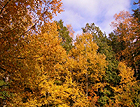Fall perennials
The best plants for the garden in Autumn sometimes have summer colour as well, says Mark Griffiths


I became familiar with Amsonia when making a garden of medicinal plants for the Royal College of Physicians in Regent's Park. These hardy herbaceous perennials qualified for inclusion on two counts. Firstly, Native Americans made a poultice of them as a remedy for snake bite. Secondly, their name commemorates Dr John Amson, an English medic and amateur botanist who settled in Virginia in the 18th century. Soon after planting them in the Physicians' Garden, I began to wonder where they had been all my gardening life. I was already acquainted with Amsonia orientalis (syn Rhazya orientalis), a species from Greece and Turkey which has long been established in British gardens, but its washed-out slate-blue flowers had never really grabbed me. Its North American cousins, popularly known as blue-stars, were a different matter.
They all conform to the same Amsonia blueprint an upright clump of slender leafy stems topped with trusses of starry blue flowers in late spring and early summer but they have so much more to offer than their Balkan cousin. Amsonia illustris, for example, makes a 3ft-high shuttlecock of growth covered in lance-shaped laurel-dark leaves and crowned with lilac pyramids. By contrast, A. hubrichtii is a luminous lime-green mist of thread-like leaves picked out with opal flowers. Somewhere between these two in terms of figura is A. tabernaemontana var. salicifolia, with willowy sea-green foliage and black-stalked bouquets of Wedgwood blue.
Although I have only recently had an opportunity to plant it, I encountered this last variety long ago when tramping around Delaware. It was growing on a woodland fringe mingled with Chasmanthium latifolium, a superb plant that combines the foliage of a miniature bamboo with the papery dancing flowerheads of an outsize quaking grass. Amsonia is a forgiving genus full sun or part shade, rocky rubbish or gourmet loam, it does not seem to care. It suits mixed and classic herbaceous borders equally. But it seems to me that Nature's way might be the best; as in the Delaware wilderness, that combination of bluestar and ornamental grass on a dampish rich soil is hard to beat both aesthetically and horticulturally. This was confirmed for me in June when I encountered the easternmost bluestar, Amsonia elliptica, in the mountains of northern Japan among daylilies and the grass Pennisetum alopecuroides in a heavenly muddle of sky blue, pale gold and apple green. A repeat performance of this trio is planned for my own meagre patch as soon as I can make space.
The fact that these bluestars are only now becoming widely available makes mention of them timely, as does their suitability for the modern planting techniques of matrix and meadow. But my reason for eulogising a group of summer-flowering perennials in October is that they also have outstanding autumn colour: the billowing, feather-fine Amsonia hubrichtii becomes a lambent cloud of amber. A good plant of Amsonia illustris (try Hardy's Cottage Garden Plants, 01256 896533; www.hardys-plants.co.uk) flushes with metallic aubergine before finishing in tints of toffee and topaz, so providing the herbaceous equivalent of my best-loved autumnal tree, Fraxinus angustifolia Raywood.
For fall foliage, bluestars are not the only perennials that hold a candle to their woody counterparts. The purple loosestrife Lythrum salicaria Robert finishes in a spectacular fire dance, and the cypress spurge Euphorbia cypar-issias Orange Man becomes a delightful tangerine tangle. (Both are rampageous: use with caution.) Of groundcovers, Persicaria affinis turns rich rust; Geranium sanguineum and G. macrorrhizum flush and blush in drought or cold; and the tougher barrenworts such as Epimedium pinnatum subsp. colchicum Black Sea take on beetroot tints that deepen as winter approaches. In damper, shadier parts of the garden, Hostas and Solomon's Seal (Polygonatum) fade to pale honey, and the lacy hummocks of Aruncus aethusifolius and low-lying fans of Mukdenia rossii Karasuba renounce their wonted subtlety and speak out in accents of cayenne and carnelian.
Pre-eminent throughout are the grasses. Misty, tawny and foxy, they are autumn perennials par excellence. Imperata, Pennisetum, Panicum, Hakonechloa, Miscanthus Purpurascens, Schizachyrium, and Calamagrostis brachytricha will paint the garden with tones that are by turns claret, cupreous and coruscating, erasing all memory of our St Swithun's summer.
Exquisite houses, the beauty of Nature, and how to get the most from your life, straight to your inbox.
Country Life is unlike any other magazine: the only glossy weekly on the newsstand and the only magazine that has been guest-edited by His Majesty The King not once, but twice. It is a celebration of modern rural life and all its diverse joys and pleasures — that was first published in Queen Victoria's Diamond Jubilee year. Our eclectic mixture of witty and informative content — from the most up-to-date property news and commentary and a coveted glimpse inside some of the UK's best houses and gardens, to gardening, the arts and interior design, written by experts in their field — still cannot be found in print or online, anywhere else.
